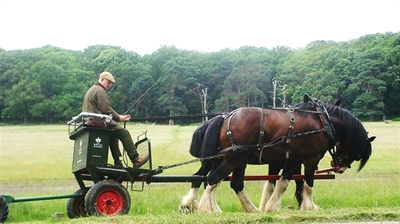See video here
filmed and edited by Adam Baranowski for Friends of Richmond Park; music is from montanaskiesmusic.ning.com with thanks to Ed and Tom from Operation Centaur.
Managing the Park involves balancing the interests of visitors with conservation concerns. However, even within conservation there are competing interests, as bracken management illustrates.
Bracken is found abundantly in the Park where it forms large colonies. Easily recognisable, in spring its uncurled fronds appear like tender green croziers or ‘fiddle heads’. By summer, the fronds have unfurled to create waist-high forests that then die back by the end of autumn.
Bracken is a very successful species, the world’s most abundant fern. It is invasive, its roots spreading quickly underground, and it outcompetes other plants and grasses that spread by seed germination. It has a liking for acid grassland and a third of Richmond Park’s acid grassland is already covered by bracken with the area increasing year by year. Richmond Park’s SSSI (Site of Special Scientific Interest) status is partly due to its acid grasslands and bracken is becoming a threat to this status.
It is, of course, not all one sided. Bracken provides vital habitat for many of the Park’s rarer birds. Stonechats, Reed Buntings and Meadow Pipits nest in it and in winter, Goldcrests and Dartford Warblers feed in the jungle of dying fronds. It also provides safe havens for resting migrant birds since it creates natural barriers to people and dogs. Deer don’t eat bracken, unlike bramble and other scrub, so its useful cover remains for much of the year. Indeed, deer use it to hide their young.
Park management uses two main methods for bracken control – rolling and spraying. Rolling is done by Shire horses, hired from Home Park and stabled at Holly Lodge (The Royal Parks had its own two Shires until 2013). This year it is likely that two horses, Royale and Aragon, will do much of the work. Rolling takes place in summer and involves the horses dragging adapted rollers, which flatten and partly break the stalks. Rolling needs to be repeated for several years and is slow and expensive but arguably longer lasting.
The other method involves spraying the bracken in the summer with a herbicide. This is very effective and poisons the rhizomes (roots). However, there is only a two-month window when it works best and it is difficult to get even cover, and herbicides are often controversial.
A balanced approach to the control of bracken that takes into account the needs of the many species that depend on it should ensure the preservation of its rightful place in the Park’s flora but also protect the Park’s acid grassland.
Article by Hugh Bradshaw


